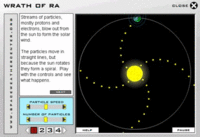
When it comes to launching spacecraft, the U.S. federal government has two main installations. The Eastern Range is comprised of the launch pads at Cape Canaveral Air Force Station and Kennedy Space Center in Cocoa Beach, Florida. This is where they launch the space shuttle and all other manned spacecraft. Also, all interplanetary spacecraft and any Earth-orbiting satellite with an inclination (angle the satellite's trajectory makes with the equator) less than 57 degrees launches from the Eastern Range. These spacecraft take off toward the east or northeast, taking advantage of the fact that the Earth already rotates in that direction, giving the satellite a boost of angular momentum. The 57 degree limit (which at least applies to space shuttle launches) comes from the fact that, if a satellite launched in a direction that is more than 57 degrees toward the north, it would be launching over populated areas of the east coast. People don't appreciate it when debris from spacecraft (or the shuttle's solid rocket boosters) fall on them from the sky. The ascent stages of these rockets need to occur over unpopulated areas, and the Atlantic Ocean fits that bill. Note: not all countries have that luxury in their spaceport location. Russian rockets taking off from Plesetsk Cosmodrome in Russia, or Baikonour Cosmodrome in Kazakhstan, have been known to rain debris down over the rural plains. Farmers have been known to sell pieces of Russian spacecraft to supplement their income.
The Western Range is located at Vandenberg Air Force Base near Point Arguello, north of Santa Barbara, California. This launch site is less talked about, probably since no manned spaceflights are launched there, and no interplanetary missions either. This site specializes in polar orbitting satellites. The Eastern range can't deliver polar orbits, since there are populated areas both due north (east coast) and due south (islands of the Carribean, and South America). The Western Range, however, has a clear path over the Pacific Ocean to the south. Vandenberg also is the launch site for various military launches, including Minuteman ICBM's, which it launches (without armed warheads, of course) toward the South Pacific for test purposes.
Launches from Vandenberg can be visible by residents of much of the southwest United States, depending on the lighting conditions. Last night, Thursday September 22nd, there was an especially cool launch. At 7:24 pm Pacific Daylight Time, not long after sunset, a Minotaur rocket launched the "Streak" satellite (a DARPA - Defense Advanced Research Projects Agency project) into a polar orbit. Since the sun had set for southern California, it was nice and dark on the ground. As the rocket gained altitude, it re-entered sunlight. This resulted in the rocket's exhaust being illuminated by the sun, while the rest of the sky was dark. A beautiful sight. I took a few snapshots from the roof of my apartment building in Sherman Oaks. You can see the other snapshots at: http://www.kodakgallery.com/I.jsp?c=l18zr2p.a18pmpx&x=0&y=nehon4. While Vandenberg launches something once every month or so, a nice, visible, dusk launch like this is a bit more rare, occurring every few years or so.
Having grown up in San Diego, I had seen the remnant exhaust trails of such launches before, but I'd never watched one while it was actually happening. It was beautiful! It looked like a giant comet shooting skyward.
For more infor on Vandenberg's rocket launches, and other space events relevant to the southern California area, check out SpaceArchive: http://www.spacearchive.info/index.htm

